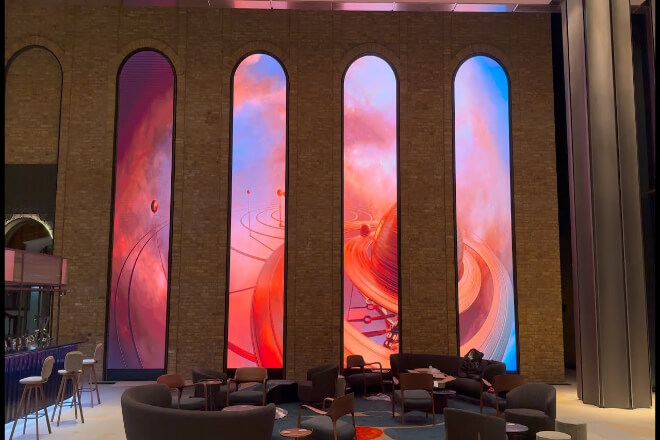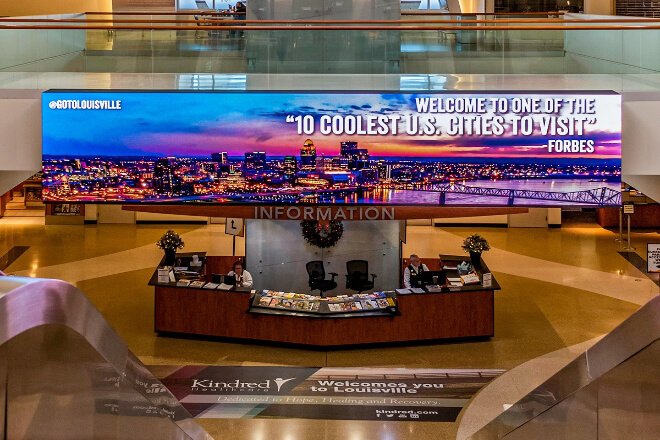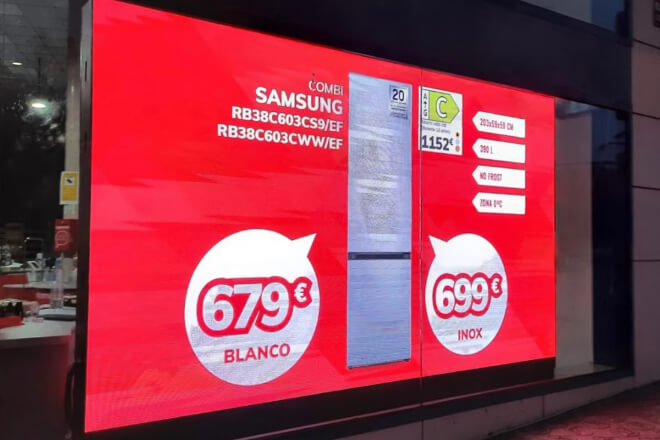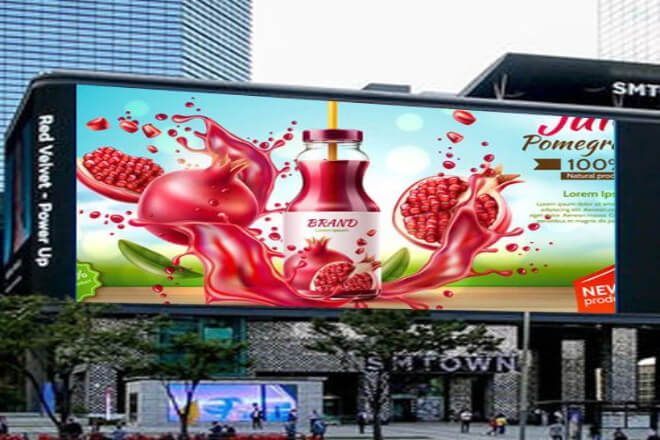介绍
目录
1. The relationship between the brightness of LED display screens and attracting attention

The brightness of LED display screens can indeed attract people’s attention. After all, the human eye is naturally more sensitive to bright objects.
Especially when the picture suddenly becomes brighter, people can’t help but take a second look.
However, if the 亮度 of the screen is too high, or the brightness changes too frequently, it will make people feel uncomfortable in their eyes and even disgusted.
Over time, the audience may simply stop watching because of this uncomfortable visual experience.
Therefore, the higher the brightness, the better. The screen that can really attract people is often moderately bright and has clear layers of pictures.
For example, set the background slightly darker and adjust the key content brighter. In this way, through the contrast between light and dark.
The picture will appear clearer and more layered. Not only does it look comfortable, but the information is also easier for the audience to remember.
In general, when choosing an LED display, you should not only focus on the brightness parameters but also consider the overall visual effect and viewing experience.
After all, the most important thing is to make the audience willing to watch actively and watch comfortably, rather than simply pursuing the “bright” effect.
2. Which is more important between the brightness of the LED display and the content?

1). Content attractiveness VS pure brightness
In fact, for LED displays, what really catches the audience’s eye is the content. No matter how bright the screen is.
If the content on it is dry, the audience will just take a look and leave, leaving no impression at all.
It’s like you pass by a store, if the things in the window are not novel, no matter how bright the lights are, you can’t attract you to go in.
On the contrary, if the content is interesting and creative, even if the screen brightness is not that high, people can’t help but take a few more glances.
Therefore, content is the “soul” of the LED display, and brightness is just a “supporting role”; it cannot be expected to save the shortcomings of the content.
2). Too high brightness will be “eye-catching” but not necessarily “touching”
Relying solely on brightness to attract people can sometimes backfire. Imagine that you are walking on the street and suddenly see a dazzlingly bright LED display.
You may be dazzled at first, but after a long time, your eyes will feel uncomfortable or even a little disgusted.
Moreover, the screen that only relies on brightness to support the scene looks “empty” and has no connotation.
The audience may be attracted at first, but they will soon feel bored and will not be really interested at all.
So, although brightness can make people pay attention to the screen, in order to really impress the audience, it still depends on attractive content.
3). Example comparison:
There are many examples in reality that can illustrate this point. For example, in a shopping mall, there are two LED displays placed together.
One is very bright, and the picture color is very bright, but the content is just a simple product picture, without any fancy features.
The other one is not so bright, but the content is designed very carefully, with a sense of story, and some dynamic effects, showing the product features clearly.
The result? The latter has a significantly higher click-through rate and audience stay time.
There is also an information screen at the subway station. It is a very bright screen with only a few words. Everyone just glances at it and walks away.
And another screen with moderate brightness has a clear text layout and some small animations to assist, so everyone is more willing to stop and watch.
All these show that a well-designed LED display with moderate brightness can capture the audience’s heart more than a screen that simply relies on brightness to support the scene.
3. The real demand for LED display brightness in different scenarios

1). Necessary high brightness under direct sunlight outdoors
Outdoors, especially in places with direct sunlight, the brightness of the LED display must be high enough, otherwise it cannot be used normally.
Imagine that you are walking under the sun and looking up at an LED display. If the brightness is not enough, the picture will be “flooded” by the sun, and you can’t see anything clearly.
In this case, the brightness of the LED display must be at least 4500cd/m², or even higher, so that people can see the content clearly under strong light.
For example, at the station, if the LED display screens that display train information are not bright enough, passengers may miss the train.
There are also advertising screens outside 购物广场. If they are not bright enough, they will not attract passers-by at all.
Therefore, outdoor LED displays must be “dazzling” so that they can “stand firm” in the sun.
2). “Low brightness priority” in indoor/nighttime environments
When you are indoors or at night, the brightness of the LED display must be reduced. At this time, the light itself is relatively dim.
If the LED display is still as bright as outdoors, the audience’s eyes will not be able to bear it and will get tired after watching it for a while.
Therefore, the brightness of LED displays indoors and at night is generally around 800cd/m².
For example, in a conference room, 酒吧, or small theater, the screen brightness is too bright, and it will make people feel dazzling.
Low-brightness LED displays are not only comfortable to watch, but also save electricity and extend the service life of the screen.
3). Typical scenarios of high-brightness applications
3.1). Stations:
The LED display screens at the station must be bright enough so that people can see the train information clearly, even in the sun.
For example, in the waiting hall of a high-speed railway station, those large screens display the train number and platform information.
If the brightness is not enough, passengers may not be able to find their own trains.
Therefore, the brightness of the LED display screen at the station must be high enough so that it can work properly under various lighting conditions.
3.2). 购物广场:
The LED display screens on the facades of shopping malls are designed to attract passers-by to enter the store. These screens must be bright enough to attract attention in the daytime sun.
Moreover, some atrium advertising screens in shopping malls also need a certain brightness to highlight the characteristics of the products and attract customers’ attention.
3.3). 户外广告:
Outdoor advertising is the “home court” of high-brightness LED display screens.
For example, on roadside billboards or large screens in city squares, insufficient brightness will not attract people at all.
Only when it is “dazzling” can people see the content of the advertisement clearly in the sun and attract the attention of passers-by.
4. Negative effects that high brightness of LED display screens may cause

1). Light pollution and visual fatigue
High-brightness LED display screens can easily become the source of “light pollution” at night or in indoor environments.
Imagine that you are walking on the street at night and suddenly a particularly bright LED screen dazzles your eyes. The glare is really uncomfortable.
This kind of strong light will not only make your eyes tired, but it may also cause vision loss if you are exposed to it for a long time.
For example, in some shopping malls, there are LED displays with super high brightness. Although it looks dazzling, many people will feel sore eyes or even dizzy after watching it for a while.
This is because the high-brightness screen will cause the pupils of the eyes to shrink continuously, and it will be very tired after a long time.
2). Interference with surrounding businesses or traffic
For surrounding businesses, high-brightness LED displays may be a “double-edged sword”. On the one hand, it can attract the attention of passers-by and bring potential customers.
On the other hand, if the brightness is too dazzling, it will make passers-by feel irritated and even affect the normal operation of other shops around.
For example, on some narrow streets, the strong light of the LED screen may shine into the shops next to it, interfering with their normal business.
What’s more serious is that high-brightness LED displays will also interfere with traffic at intersections or on both sides of the road.
If the brightness of the LED screen is too high, or the screen switches too quickly, the driver may be dazzled and cannot see the road signs or the vehicles on the opposite side, which can easily cause traffic accidents.
For example, on the main roads of some cities, drivers reported that when they passed those high-brightness advertising screens at night, the strong light would temporarily blind them, which was very dangerous.
3) The user’s psychological analysis of “strong light interference”
From the user’s perspective, people’s tolerance for strong light Interference is actually very low.
For example, residents living near advertising screens who can’t sleep at night because of the strong light will definitely feel disgusted with the screen.
Moreover, when people are shopping or driving, they are suddenly stimulated by strong light.
The unpleasant feeling will greatly reduce their overall impression of the surrounding environment.
Many people will feel that this kind of strong light Interference not only affects their normal life, but also seems very “unfriendly”, as if forcing them to accept this dazzling light.
5. New trends in LED display brightness adjustment technology

Now, many LED displays are equipped with a “little eye” – an ambient light sensor. This thing is very smart and can “see” the surrounding light conditions in real time.
If it is sunny outside, the display will automatically brighten so that you can see clearly; if it is at night or the indoor light is dim, it will automatically dim so that your eyes will not hurt.
This system not only makes the audience feel comfortable, but also saves electricity, killing two birds with one stone.
For example, some high-end LED screens can also adjust the brightness by zone. It is like dividing the screen into different “small rooms”.
Each area adjusts the brightness separately according to the light conditions, avoiding the screen flickering due to the rapid change of light, which makes people feel uncomfortable.
This technology is also very interesting, which is to automatically adjust the brightness according to different time periods of the day.
For example, when the sun is strong during the day, the screen is brightened; at night, the screen automatically dims.
This not only allows the screen to maintain appropriate brightness in different time periods, but also extends the service life of the screen and reduces unnecessary energy consumption.
For example, you see those outdoor advertising screens in the city, which are dazzling during the day and become much softer at night. This is the credit of time-sharing automatic dimming.
This logic is not only applicable to outdoor displays, but also to indoor displays.
For example, the LED screen in the conference room can be brighter during the day and dimmed at night, so that everyone can watch it comfortably.
Nowadays, many LED display screens use intelligent control software, which is much more convenient than the previous manual adjustment.
This software can automatically adjust the screen brightness according to the data of the ambient light sensor, and can also provide personalized adjustment solutions according to different scenarios.
For example, the PWM+PAM hybrid drive technology of Nova Nebula sounds complicated, but in simple terms, it can make the screen brightness adjustment very fine, with an accuracy of 0.001nit.
This means that the screen can remain clear even at low brightness, without flickering or color distortion.
In addition, these software can automatically adjust the content and brightness according to the audience’s habits.
For example, in a shopping mall, the brightness and content of the advertisement are automatically adjusted according to the customer’s stay time, which is both energy-saving and attractive.
6. 结论
Brightness can attract attention, but it cannot keep the eyes. What really impresses the audience is never the dazzling light, but the warm and creative content.
Next time, when you are attracted by a screen, think about it: Is it the light that speaks, or is it the content that shines?
最后,如果您想了解更多关于LED显示屏的知识, 请与我们联系.

